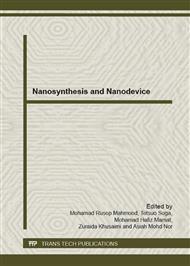[1]
K. Sano, T. Akiyama, K. Nakamura and T. Ito, A Monte-Carlo simulation study of twinning formation in InP nanowires, Journal of Crystal Growth, 301-302 (2007) 862-865.
DOI: 10.1016/j.jcrysgro.2006.11.325
Google Scholar
[2]
I. Regolin, D. Sufdeld, S. Luttjohann, V. Khorenko, W. Prost, J. Kastner, G. Dumpich, C. Meier, A. Lorke, and F. J. Tegudej, Growth and characterisation of GaAs/InGaAs/GaAs nanowhiskers on (111) GaAs, Journal of Crystal Growth, 298 (2007) 607-611.
DOI: 10.1016/j.jcrysgro.2006.10.122
Google Scholar
[3]
K. A. Dick, K. Deppert, L. Samuelson, and W. Seifert, InAs nanowires grown by MOVPE, Journal of Crystal Growth, 298 (2007) 631-634.
DOI: 10.1016/j.jcrysgro.2006.10.083
Google Scholar
[4]
D. M. Cornet and R. R. LaPierre, InGaAs/InP core-shell and axial heterostructure nanowires, Nanotechnology, 18 (2007) art. no. 385305.
DOI: 10.1088/0957-4484/18/38/385305
Google Scholar
[5]
S. K. Lim, M. J. Tambe, M. M. Brewster, and S. Gradecak, Controlled growth of ternary alloy nanowires using metalorganic chemical vapor deposition, Nano Letters, 8 (2008) 1386-1392.
DOI: 10.1021/nl080129n
Google Scholar
[6]
Y. Kim, H. J. Joyce, Q. Gao, H. H. Tan, C. Jagadish, M. Paladagu, J. Zou and A. A. Suvorova, Influence of nanowire density on the shape and optical properties of ternary InGaAs nanowires, Nano Letters, 2006 Vol. 6, No. 4 599-604.
DOI: 10.1021/nl052189o
Google Scholar
[7]
T. Sato, J. Motohisa, J. Noborisaka, S. Hara and T. Fukui, Growth of InGaAs nanowires by selective-area metalorganic vapor phase epitaxy, Journal of Crystal Growth, 310 (2008) 2359-2364.
DOI: 10.1016/j.jcrysgro.2007.12.048
Google Scholar
[8]
R. S. Wagner and W. C. Ellis, Vapor-liquid-solid mechanism of single crystal growth, Applied Physics Letters, 4 (1964) 89 - 90.
DOI: 10.1063/1.1753975
Google Scholar
[9]
E. Wibowo, Z. Othaman, S. Sakrani, A.S. Ameruddin, D. Aryanto, R. Muhammad, I. Sumpono, H. Hamidinezhad, Journal of Fundamental Science, Vol. 6, No. 2(2010) 131-135.
Google Scholar
[10]
E. Wibowo, Z. Othaman, S. Sakrani, I. Sumpono, The advantage of low growth temperature and V/III ratio for InxGa1-xAs nanowires growth, NANO, Vol. 6, No. 2, World Scientific Publisher (2011).
DOI: 10.1142/s1793292011002457
Google Scholar
[11]
G. Cau, Nanostructures & Nanomaterials, Synthesis, Properties & Applications, Imperial College Press, London, (2003).
Google Scholar
[12]
H. J. Joyce, Q. Gao, Y. Kim, H. H. Tan, and C. Jagadish, Growth, structural and optical properties of GaAs, InGaAs and AlGaAs nanowires and nanowire heterostruetures, Proceddings of the 20th Annual Meeting of the Lasers and Electro-Optics Society, USA, Florida, Lake Buena Vista, 21-25 October 2007 art. no. 4382451, 407-408.
DOI: 10.1109/leos.2007.4382451
Google Scholar
[13]
M. Omari, N. Kouklin, G. Lu, J. Chen, and M Gajdardziska-Josifovska, Fabrication of Cd 3As 2 nanowires by direct vapor-solid growth, and their infrared absorption properties, Nanotechnology, 19 (2008) art. no. 105301.
DOI: 10.1088/0957-4484/19/10/105301
Google Scholar
[14]
K.W. Kolasinski, Catalytic growth of nanowires: Vapor-liquid-solid, vapor-solid-solid, solution-liquid-solid and solid-liquid-solid growth, Current Opinion in Solid State and Materials Science, 10 (2006) 182-191.
DOI: 10.1016/j.cossms.2007.03.002
Google Scholar
[15]
E. I. Givargizov, Fundamental aspects of VLS growth, Journal of Crystal Growth, 31 (1975) 20-30.
DOI: 10.1016/0022-0248(75)90105-0
Google Scholar
[16]
K. A. Dick., D. Knut, L. Samuelson and W Seifert, Optimization of Au-assisted InAs nanowires grown by MOVPE, Journal of Crystal Growth, 297 (2006) 326-333.
DOI: 10.1016/j.jcrysgro.2006.09.054
Google Scholar


